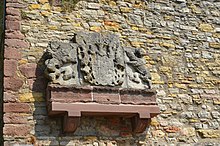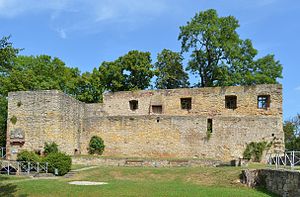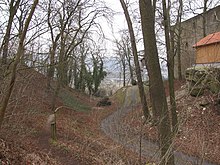Heldenburg
| Heldenburg | ||
|---|---|---|
|
The Junkerhaus as the north face of the castle ruins, seen from inside the castle |
||
| Alternative name (s): | Salzderhelden Castle | |
| Creation time : | around 1100 to 1200 | |
| Castle type : | Hilltop castle | |
| Conservation status: | Wall remains | |
| Standing position : | Count | |
| Place: | Salzder heroes | |
| Geographical location | 51 ° 47 '59.5 " N , 9 ° 54' 45.3" E | |
|
|
||

The Heldenburg , also known as Salzderhelden Castle , is a ruined castle above the town of Salzderhelden in southern Lower Saxony . It served to protect the salt well at the foot of the castle complex, from which the Salzderhelden salt works developed. Between 1291 and 1596 it was the residence and at times the main residence of the dukes of the Guelph Principality of Grubenhagen .
Name origin and Sachsenross
The origin of the name is probably the same as for the place Salzderhelden , comes from the word " Halde " and describes the castle "on the Halde". On the occasion of his assumption of government in Salzderhelden in 1361, Duke Albrecht I of Braunschweig-Grubenhagen used a horse in the seal that strode to the right (heraldically), which later became the coat of arms of Lower Saxony (the Sachsenross ).
Building description
Remains of the walls of the buildings of a closed four-wing complex around a square courtyard are still preserved from the hilltop castle on the slope of the Kleiner Heldenberg. These include remains of the palace , the castle chapel on the first floor, a spiral staircase tower with 49 steps, a castle tower and two former beer cellars . The castle fountain is almost in the middle of the castle courtyard and is today marked on the surface by a stone circle. The ramparts and the large wall of the hall with toilet and fireplace are impressive. Interesting modern frescoes on the history of the castle can be found in the Burgschänke restaurant at the castle entrance.
history
For a long time, a document from 1320 was considered to be the first documented mention of the Heldenburg. The document book of the Fredelsloh monastery contains an even earlier document of the castle. On July 22nd, 1306, Count Simon von Dassel testified to the nuns of the Fredelsloh monastery that they had the right to keep 20 silver marks in two salt pans in Sale iuxta castrum Helden , i.e. in Salzderhelden near Helden Castle, until they were redeemed. The castle was built by the Counts of Dassel or the Guelphs by the 13th century at the latest . In 1291, due to its location in the newly founded principality of Grubenhagen, the castle came into the possession of Duke Heinrich Mirabilis , who made the Heldenburg his main residence and died in the castle in 1322. A lavish tournament took place in 1305. Due to its strategically favorable location near the salt spring , Grubenhagen Castle and the beer town of Einbeck , it soon became the residence of the Dukes of Grubenhagen. Many ducal graves are in the minster church in Einbeck. The dukes were soon given the nickname "von Salzderhelden". In the 15th and 16th centuries, Salzderhelden Castle was the only extra-urban mint of the Principality of Grubenhagen, along with the towns of Einbeck, Osterode and St. Andreasberg . Heinrich Mirabilis' three sons administered the land together at first, but Heinrich the Greek squandered the southern part of the country in Eichsfeld around the city of Duderstadt on his travels to the Orient , which was then pledged to the Bishop of Mainz and ultimately remained in his possession. Heinrich began to pledge parts of his rule after 1331. He probably had money worries and therefore had to withdraw from the rulership in exchange for an annuity in 1342, when he transferred his third to Hameln , Einbeck, Osterode and other Grubenhagen rights to the Archbishop of Mainz .
In 1365 the castle was besieged by Landgrave Friedrich of Thuringia with around 18,000 men. The castle was defended with a cannon and the besiegers suffered such heavy losses that they soon withdrew. This is said to have been the first case of defending a castle with a gun in German lands. In 1448 there was another siege by Landgrave Ludwig the Friedsamen of Hesse. According to tradition, the sister of the lord of the castle (Duke Heinrich III of Grubenhagen ), Elisabeth (Abbess of Gandersheim ), stayed at the castle. She outwitted the besiegers by hanging women's clothes from the castle windows. The besiegers did not want to fight against "women" and withdrew.
After the residence period

At the end of the 15th century, representative modifications were made in half-timbered houses. At the time the castle was a widow's seat . The cities of Einbeck and Osterode long resisted a bede for the renovation because the duke was impoverished.
With the Welf inheritance agreement of 1481, the dominion was relocated to the east to the main residence of Schloss Herzberg . In 1596 the castle's staff included 11 officials, such as the court marshal , and 14 other officials, such as porters, servants and cattle herders. After the extinction of the Grubenhagen line with the death of Duke Philip II of Braunschweig-Grubenhagen on April 4, 1596, Duke Heinrich Julius of Braunschweig-Wolfenbüttel initially claimed the Grubenhagen territory for himself. After long disputes over inheritance and a court ruling by the Imperial Court of Justice in 1617, the castle legally passed into the possession of the Lüneburg line of the Guelph Dukes. The son of Heinrich Julius, Duke Friedrich Ulrich , had to transfer the Grubenhagen inheritance to Christian the Elder , Prince of Lüneburg .
A Merian engraving from 1654 shows the castle building, which was still very representative at the time - Duke Philip II had major modernization measures carried out in 1590 - which, however, fell into disrepair because it was only used sporadically in the 17th century. From 1675, Johann Friedrich von Braunschweig-Calenberg is documented as the last temporary presence of a Guelph Duke at the Heldenburg. The last known resident of the castle was from 1680 to 1686 the Drost , chief forest and hunter Otto Friedrich von Moltke. He was one of the conspirators against a throne and succession law of 1683 and was beheaded in Hanover in 1692 for high treason .
18th to 21st century
The castle has been uninhabited since the 18th century. As early as 1767, their condition was described by the responsible building authorities as too bad for residential use. In 1799 an employee of the building supervision noted that the castle "collapsed, cleared away and now there is no building or grain floor there".
In the 1950s the castle festival was well attended, and there was also a museum with knight armor in the castle tavern. The part of the castle with the restaurant was then sold by the state of Lower Saxony.
The castle ruins were completely renovated from 1983 to 1988. The Burgförderverein Heldenburg looks after the castle and has been organizing excavations, castle services and events such as castle festivals since 1984. Visits to the castle complex are made possible by the tourist information office in Einbeck and the Heldenburg Castle Association.
Since 2014, the Lower Saxony State Office for Monument Preservation has supported a renewed renovation of the castle, which the State of Lower Saxony has funded with 175,000 euros. The federal government made a further 175,000 euros available to valuable cultural monuments as part of the National Monument Protection Special Program. So far, a staircase for visitors has been repaired and a retaining wall has been renovated. Furthermore, the castle walls and the eastern curtain wall will be secured. The castle complex has already been given a tour with information boards about the history of the complex and the place.
Research history
Robbery excavations took place on the castle grounds in the 1950s . They concerned the former kitchen area and the chapel. Some of them are found in the form of medieval shards, which were handed over to the municipal museum Einbeck in 1954.
Since the end of the 1990s, the archaeological preservation department of the city of Einbeck has carried out several excavations, most of which were related to renovations. These took place in 1998 and between 2006 and 2008.
In 2006, two archaeological excavation campaigns were carried out inside the castle by the Einbeck city archeology. In the process, former walking horizons in the area of the castle gate and inside the building were uncovered, and a basement of the former castle chapel by a previous building was discovered, which was apparently a guardroom. During an extensive excavation, the southern area of the Princely House was uncovered, the former floor of which was covered by a 2.2 meter thick layer of rubble. Further excavations took place in April and May 2007, during which the basement of the castle chapel was exposed. For security reasons, the castle well was only dug a few decimeters deep. The brick well shaft with a diameter of 3.5 meters was found 2.2 meters deep. During the excavations, objects typical of castles were found, such as stirrups, axes, grape vessels, combs, stove tiles, slug panes, remains of windows and colored plaster remains.
literature
- Peter Aufgebauer : The Salzderhelden Castle in: Einbecker Jahrbuch , Volume 38, pp. 19–41, Einbeck 1987
- Helge Steenweg: Life on the officials' seats and earlier residences in Salzderhelden and Rotenkirchen in the 16th and 17th centuries in: Einbecker Jahrbuch , Volume 40, pp. 1–30, Einbeck 1989
- Ernst Andreas Friedrich : The ruins of the Heldenburg , pp. 142-142, in: If stones could talk , Volume III, Landbuch-Verlag, Hanover 1995, ISBN 3-7842-0515-1 .
- Stefan W. Teuber: Old Walls - New Finds. Heldenburg zu Salzderhelden in: Archeology in Lower Saxony , 2007, pp. 114–117
- Stefan W. Teuber: News from the Heldenburg in: Archeology in Lower Saxony , 2009, pp. 137-140
- Markus C. Blaich , Sonja Stadje, Kim Kappes: The Heldenburg near Salzderhelden, castle and residence in the Principality of Grubenhagen , (= guide to the prehistory and early history of Lower Saxony. 32) Isensee Verlag , Oldenburg, 2019, ISBN 978-3-7308-1581 -6
Web links
- Entry by Jens Friedhoff zu Salzderhelden, Heldenburg in the scientific database " EBIDAT " of the European Castle Institute
- Reconstruction drawing by Wolfgang Braun
- Description by the Lower Saxony State Office for Monument Preservation
- Website of the castle's friends' association
Individual evidence
- ^ Salzderhelden, Burg at inschriften.net
- ^ Stefan W. Teuber: News from the Heldenburg . In: Archaeological Commission for Lower Saxony eV (Hrsg.): Archeology in Lower Saxony . Isensee Verlag, Oldenburg 2009, p. 139 .
- ^ HStA Hanover, Hann. 74 Einbeck, no.1074
- ↑ Land invests the Heldenburg in Einbeck-Salzderhelden. Invitation to the press conference in Einbeck on April 13, 2015
- ↑ Renovate and use the Heldenburg monument treasure in Einbecker Morgenpost from June 15, 2020
- ↑ The Heldenburg has a new staircase. Press release from the Lower Saxony State Office for Monument Preservation
- ^ The Heldenburg near Salzderhelden Publications of the Lower Saxony State Office for Monument Preservation
- ^ Stefan W. Teuber: Old walls - new finds. Heldenburg to Salzderhelden . In: Archaeological Commission for Lower Saxony eV (Hrsg.): Archeology in Lower Saxony . Isensee Verlag, 2007, p. 114-117 .



